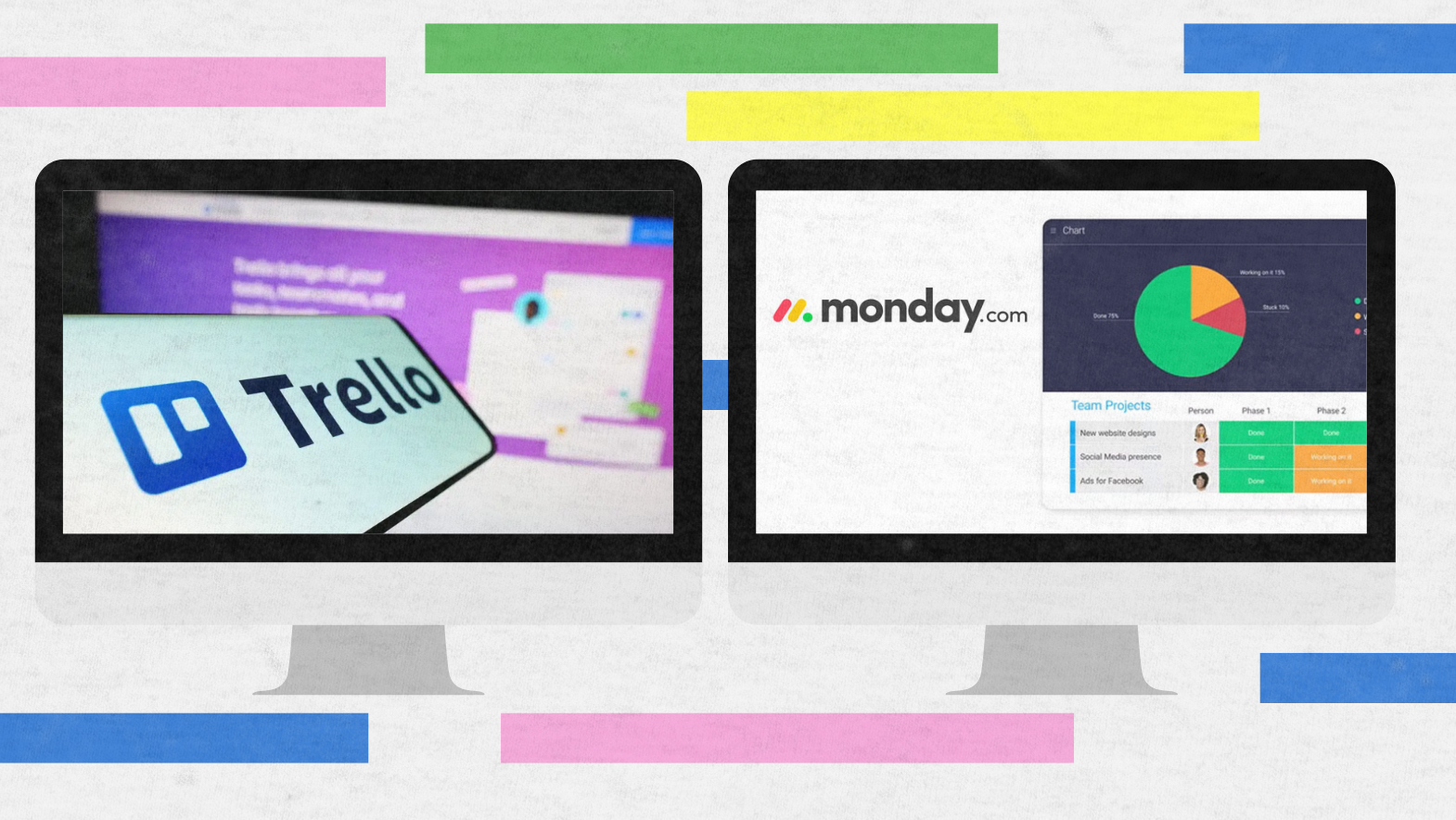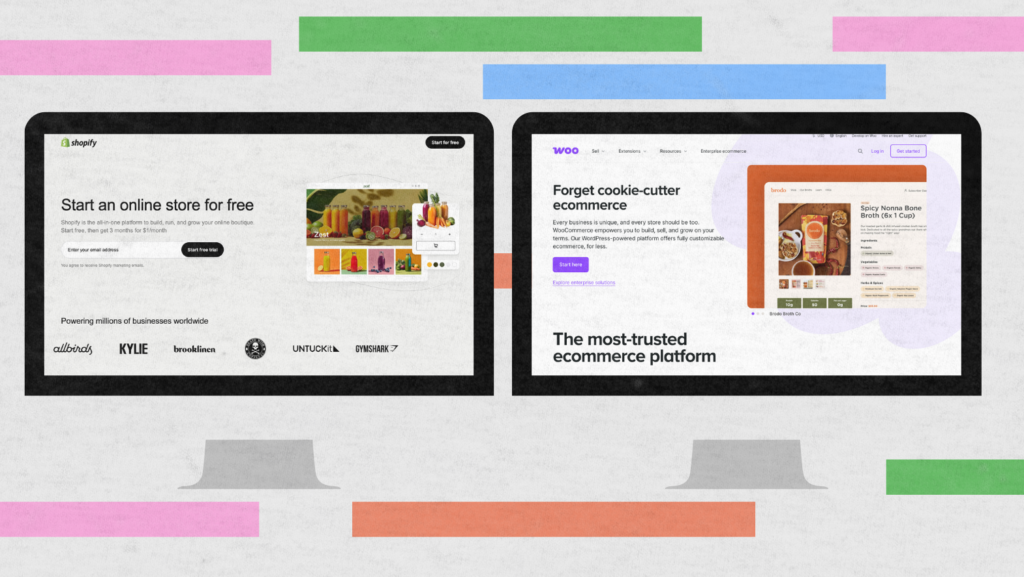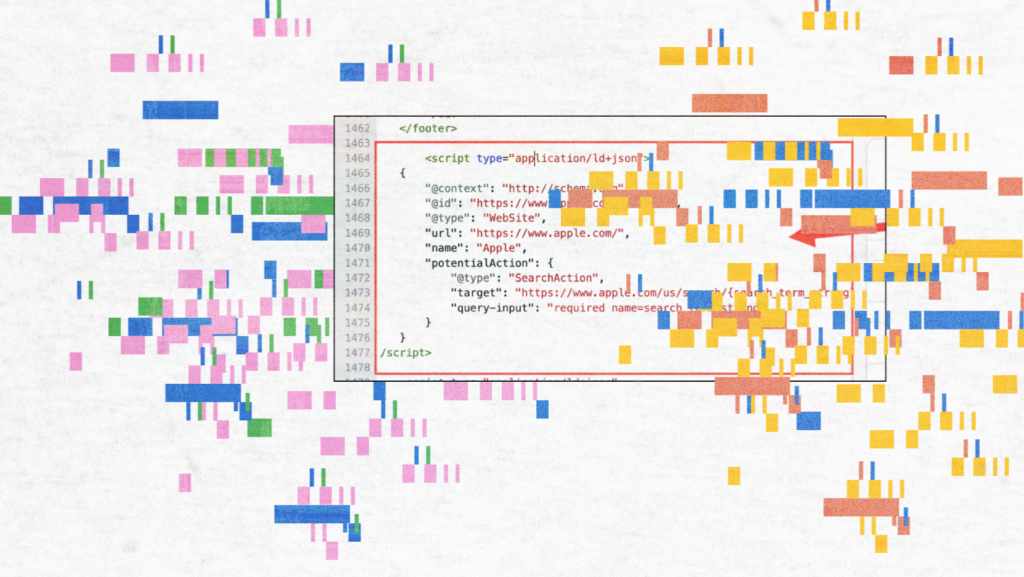What works best for project management in 2026? Remote and hybrid teams are the standard. Hence, the right project management software is not a matter of choice but a necessity for collaboration, visibility, and productivity. Trello vs Monday are among the best and most popular project management software.
Both are excellent in what they offer, but are different in many respects. Trello is more about a straightforward and fast approach with Kanban boards that are visually attractive, whereas Monday is more about the depth of features, automation, and scaling up of complex workflows.
The content here hands the comparison of Trello vs Monday over to you by looking at their setup, usability, features, pricing, and overall value. It doesn’t matter if you are leading small teams or handling large projects; you’ll understand which platform is a better fit for your objectives. Briefly, Trello is a tool that allows teams to keep up with the pace, whereas Monday helps them expand in a strategic way via connected and real-time collaboration.
Quick Comparison Table
| Feature | Trello | Monday.com |
| Best for | Simpler projects and small teams | Complex workflows and larger teams |
| Interface | Minimal and intuitive | Dynamic and feature-rich |
| Setup Time | 5–10 minutes | Hours or days (depending on setup depth) |
| Automation | Rule-based Butler automation | Advanced workflow builder |
| Collaboration | Basic comments and mentions | Real-time collaboration tools |
| Dashboards | Limited analytics | Fully customizable reporting |
| Pricing | More affordable, better free plan | Costlier but more powerful |
| Learning Curve | Very easy | Moderate to steep |
Approach & Philosophy
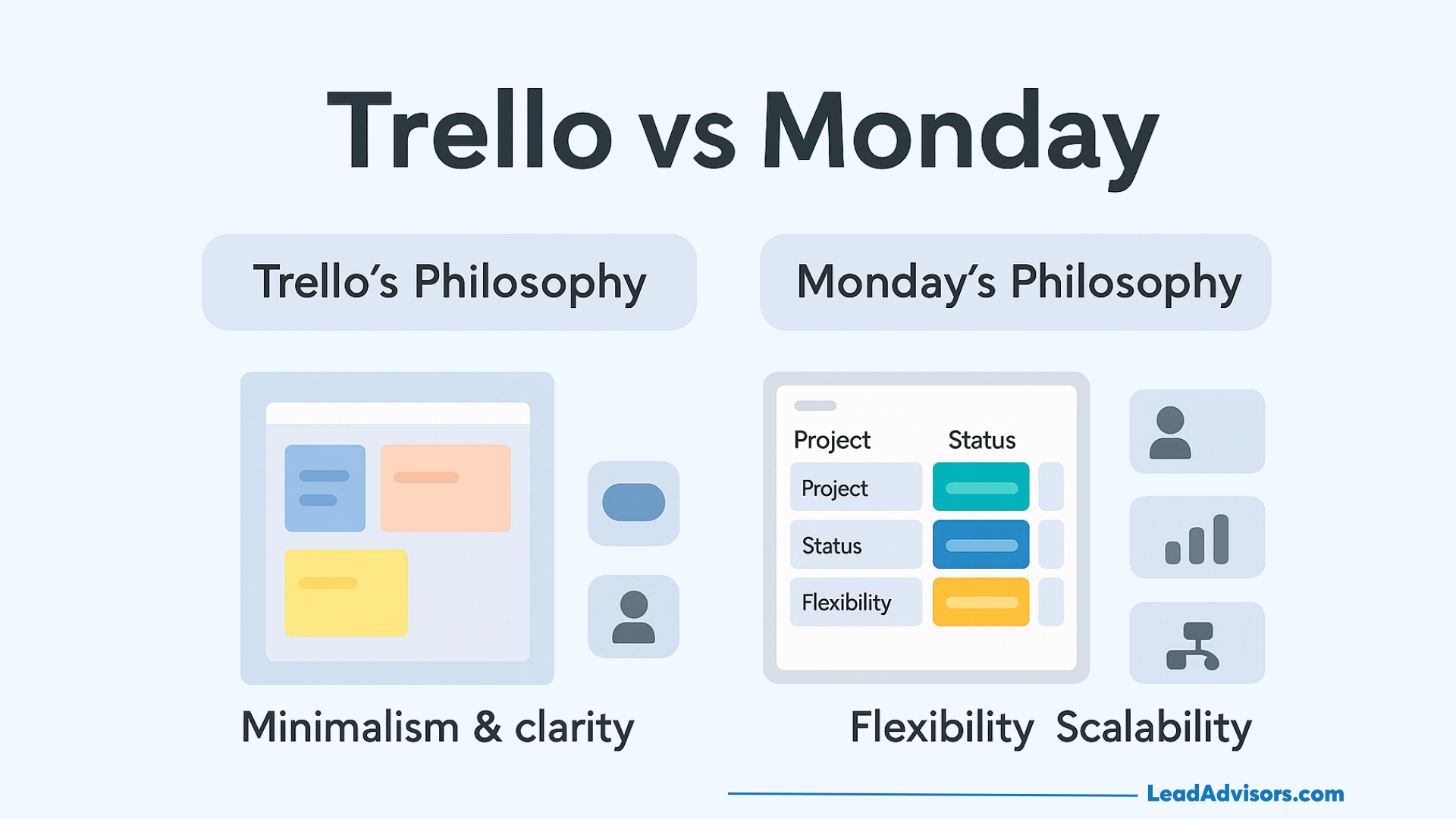
It comes down to understanding each platform’s viewpoint on work and collaboration when deciding between Monday vs Trello. Both are the best project management tools, but their philosophies cater to different teams. Trello is all about being featureless and simple, which helps a lot in projects and teams of small size that require little training to use it. Monday.com is more inclined towards structure and scalability; thus, it is a suitable organization for those who want a fully integrated work management environment.
Trello’s Philosophy
Trello revolves around minimalism and clarity. It makes things less complicated and lets the users do the work. By introducing visual Kanban boards, Trello allows teams to understand the progress at a glance and manage projects by drag and drop with ease. Users also have the freedom to comment, assign due dates, and integrate Power Ups such as Google Drive or Microsoft Teams with Trello, hence collaboration is promoted in its neat UI. Consequently, this is the best model for a startup and small teams that are in dire need of a quick organization.
Monday’s Philosophy
Monday.com acts differently in that it is a flexible work management software designed for teams whose demands are beyond only basic task management. It is capable of project management, CRM, time management, and reporting tracks in one pool of resources. The platform has plenty of customization features, for example, personal fields, Gantt charts, and automations that are able to scale alongside an enterprise. The features created for live collaboration enable cross-functional communication, resource tracking, and project transparency on Monday.
In summary, Trello is a simplifier while Monday is a systemizer. Trello is used to move rapidly, with a shortcoming in the setup, whereas Monday.com has the ability to plan, handle, and scale the business operations effectively.
Ease of Use & Setup
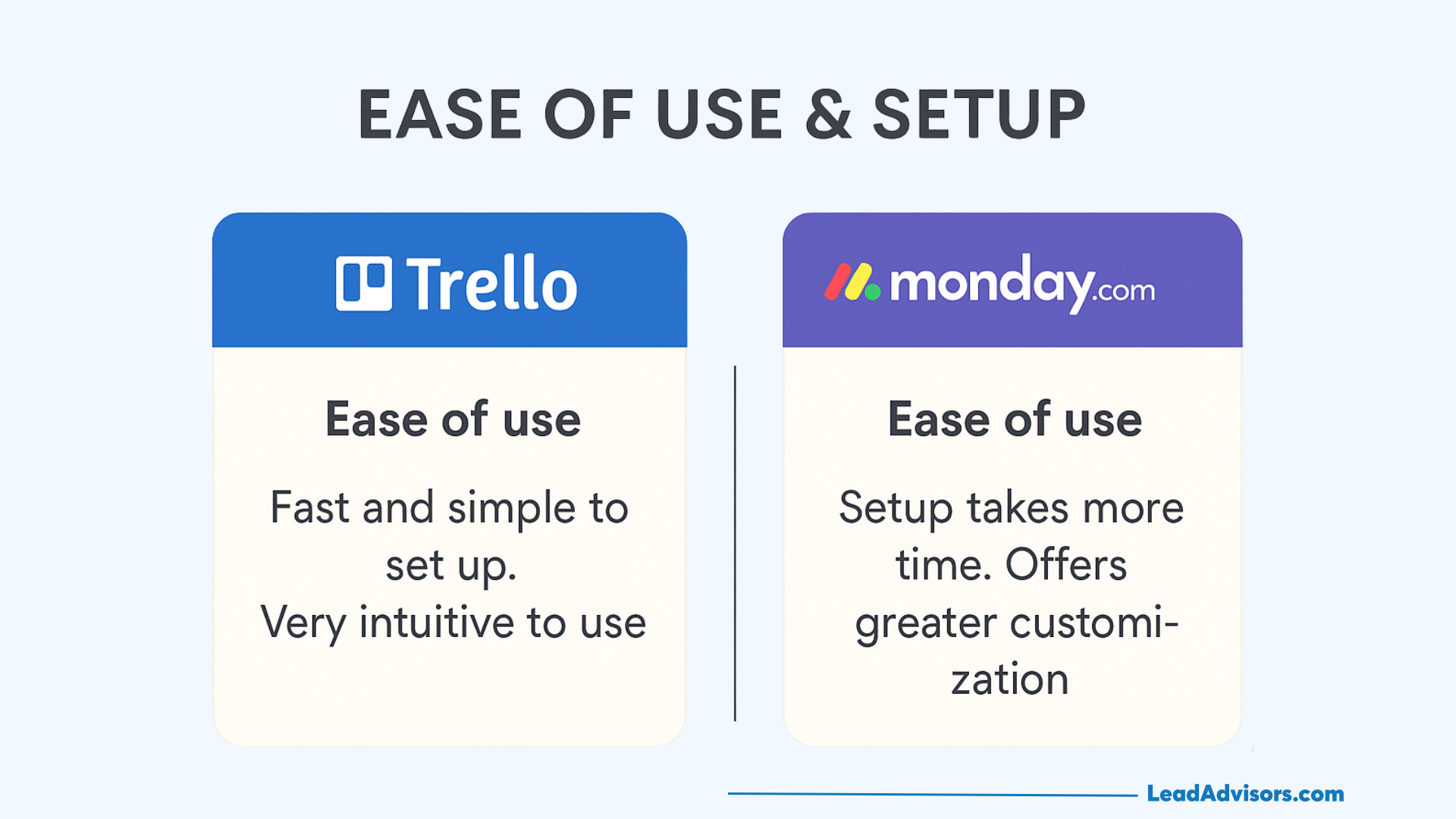
The use of comparison methods, such as Trello and Monday, to create a project management tool that is the right one largely depends on the ease of quitting the IT domain. Both software applications are targeting the simplification of the workflow; however, they are each designed for different sizes of teams and degrees of work complexity.
Trello
Trello is a software that one can hardly find faults with in terms of ease, speed of operation, and its friendliness to beginners. Within the shortest period of time, one can actually manage the tasks and do so through a visual Kanban board, which is allowed by the software. Here you can drag and drop cards, select team members, and track due dates easily.
It has advanced features, a neat and natural interface, and thus it can be ranked as one of the most user-friendly options among project management tools. Being appropriate for teams with a small number of members, it is fine for any person who is willing to be organized rapidly and without going through complicated steps in the setup process.
Monday.com
It is true that Monday.com provides more features and control, but the setup process is not as fast as with other software solutions. To customize the workflow in your case, you will have to work with the boards, columns, the dashboard, and automations. The user-friendly dashboard has a variety of colors and elements, but it might feel chaotic as your volume of work increases.
It is the team requiring extreme organization, detailed monitoring, and the use of automation that will benefit the most from this tool. Despite the platform having a steep learning curve, its adaptability and ability to grow with you make it a great choice for long-term use.
Both Trello and Monday.com offer mobile apps that mirror their desktop experience, making it easy to manage tasks, update boards, and communicate with team members from anywhere.
Feature Comparison
Both Trello and mday.com are equipped with the necessary tools to manage projects efficiently. However, their strengths differ in terms of workflow design, collaboration, and automation. The main differences between these platforms are explained below based on how they excel.
A. Task & Workflow Management
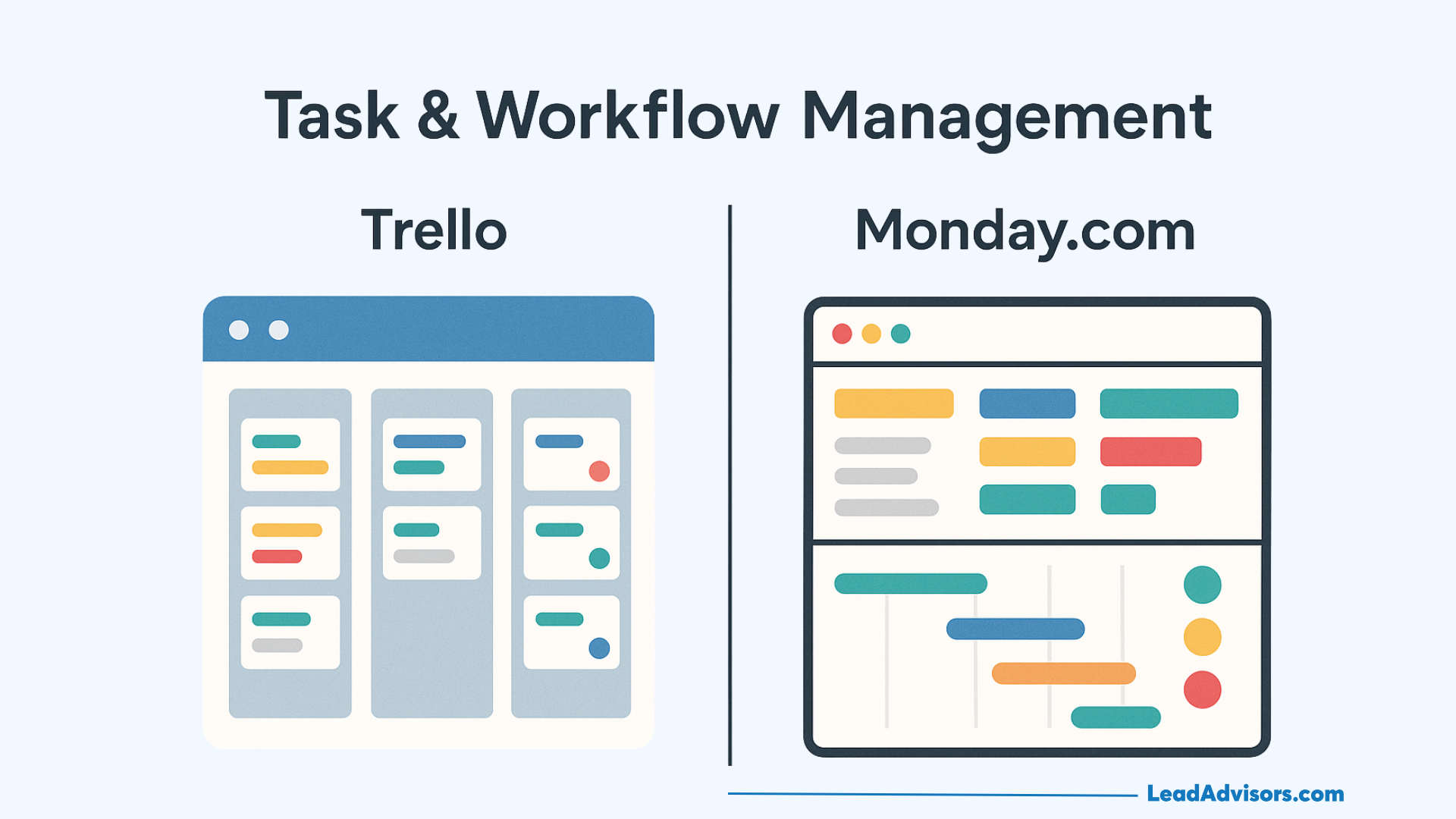
- Trello: Presents a user-friendly, visually Kanban board approach that is based on boards, lists, and cards. Using Power Ups like Gantt charts or Calendar view, you can effectively carry out your project, and due dates will be easy to track.
- Monday.com: Offers you the choice of several views, such as Kanban, Gantt, Calendar, Workload, and Timeline. It also has a very important feature of task dependencies. Besides that, it will make you and your team have better visibility as you can manage many projects from a single dashboard.
B. Collaboration
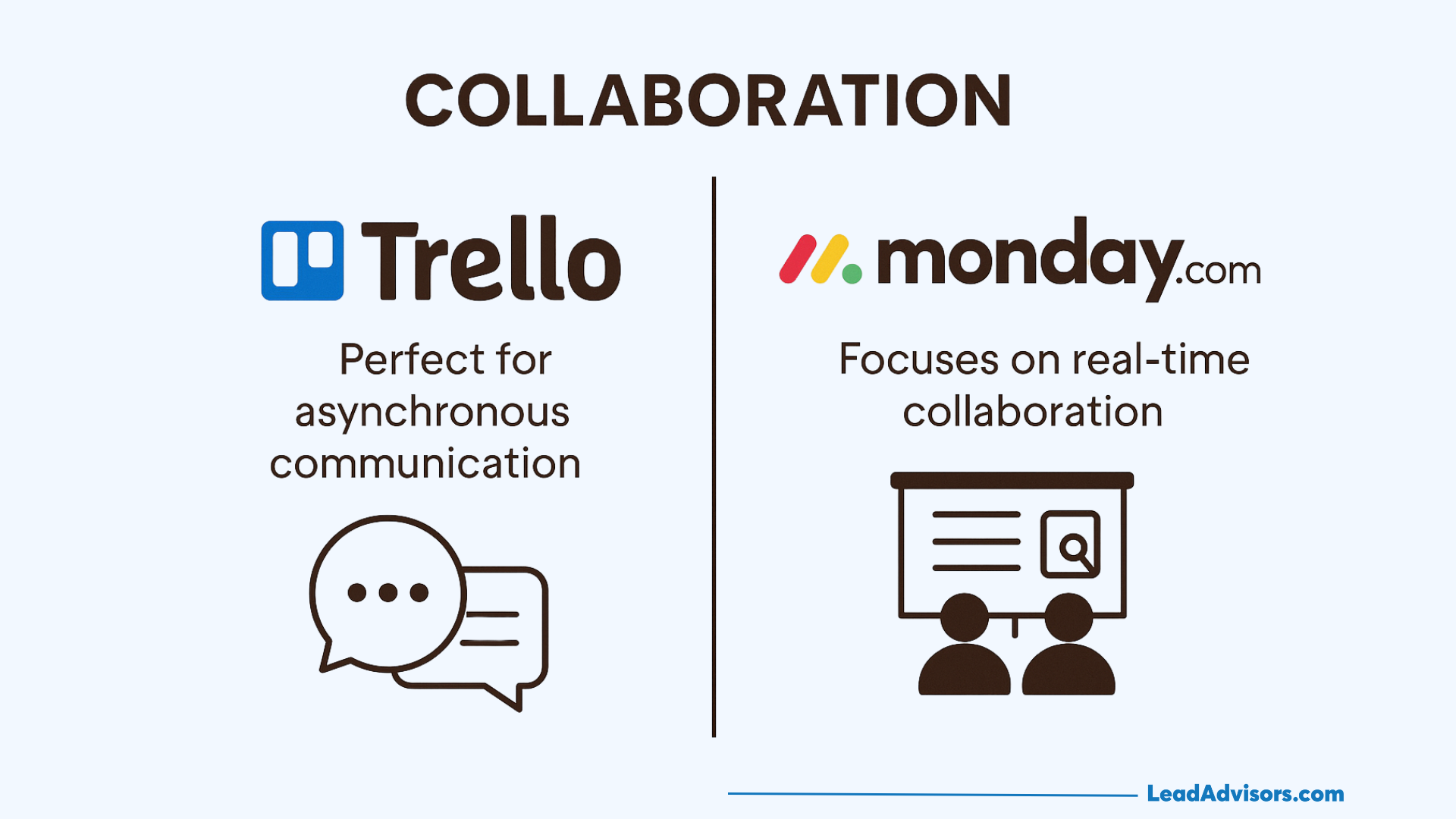
- Trello: The software is perfect for asynchronous communication within a team. Users can leave comments on a particular subject, tag the team members, and, in addition, they can attach a file to facilitate the process of exchanging information.
- Monday.com: Concentrating more on real-time collaboration, it has visual whiteboards, shared docs, and live dashboards for teams that work across different departments.
Their mobile apps support notifications, file uploads, and real-time collaboration, allowing users to stay connected and productive while away from their desks.
C. Automation
- Trello: Has a “Butler” automation tool, which is used to trigger simple operations such as moving the card when the due date is reached.
- Monday.com: A powerful automation engine that allows users to create workflows to assign tasks to people, update system status, or link multiple projects automatically is one of the major features of this platform.
D. Reporting & Dashboards
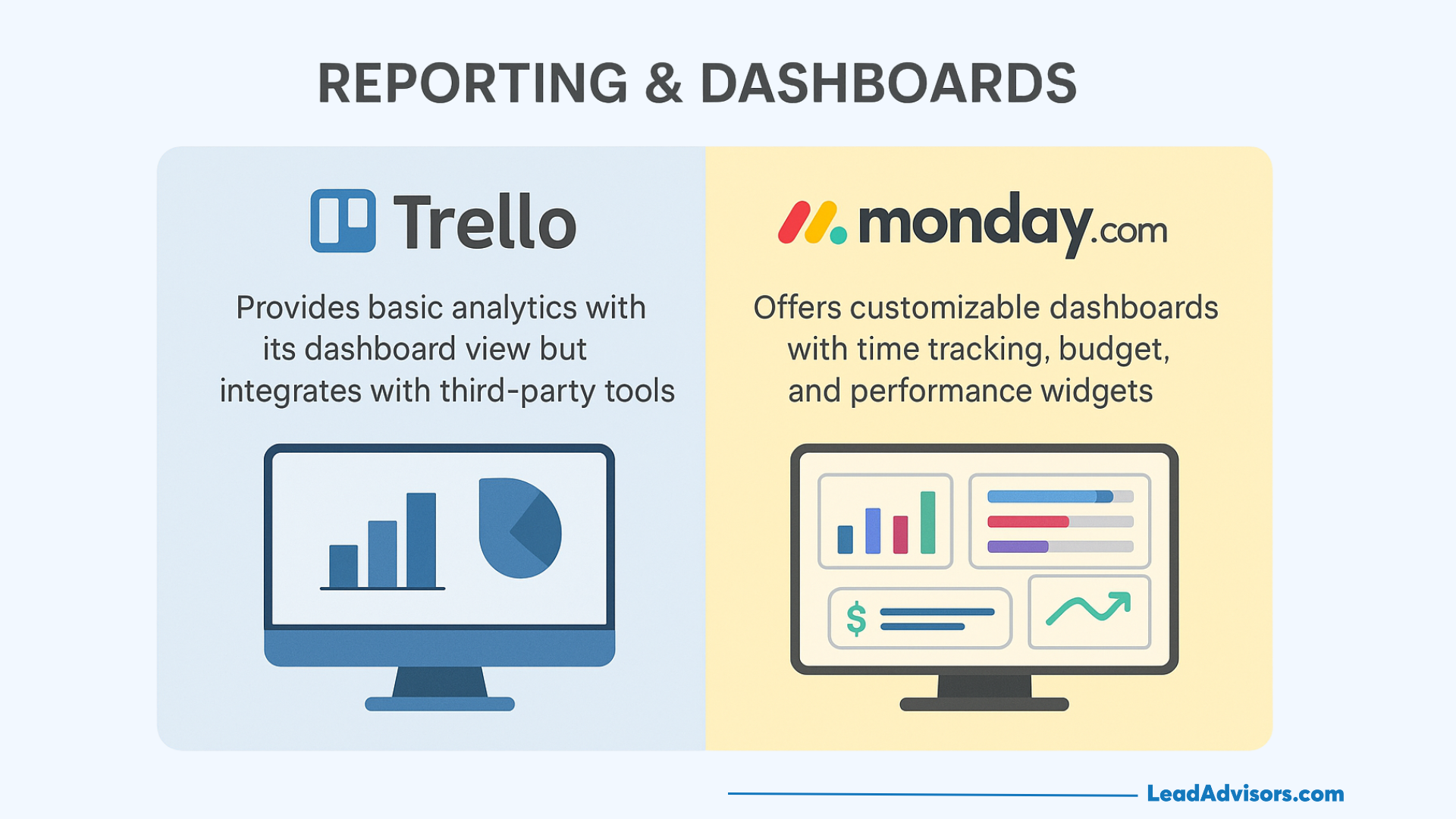
- Trello: Gives the opportunity for analytics through its dashboard view, but only at a basic level. To deepen this, users integrate third-party software tools in their work environment.
- Monday.com: Offers tailored dashboards with various widgets for time tracking, budgets, and performance measurement. Live data enables managers to spot bottlenecks quickly.
E. Integrations
Both have integration abilities with Slack, Google Drive, and Microsoft Teams, which are very important tools.
- Trello: Has integrations with all its plans, including the free ones.
- Monday.com: The depth or limit of an integration depends on which plan you are on, but it works more harmoniously within workflows.
F. Templates & Customization
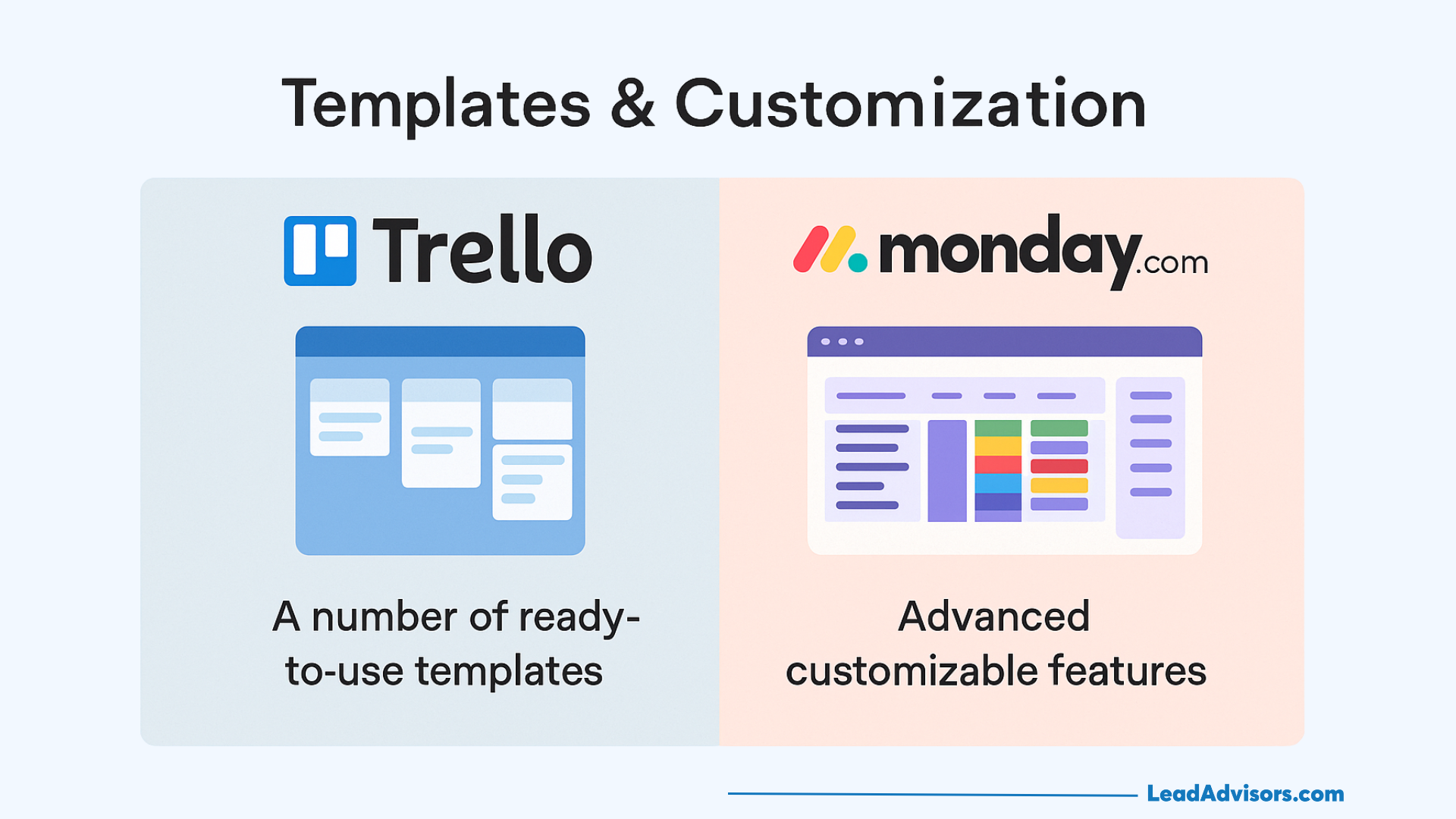
- Trello: Has a different number of ready-to-use templates for your marketing, product, or operations department out of the box; thus, teams get a fast take-off.
- Monday.com: It is by far a great tool for big teams and complicated projects, as it has so many advanced features that can be customized, like editable columns, formulas, automations, and dashboards. So it can be said that it is a perfect solution for complex projects and big teams.
Pricing & Value
Knowing the difference in Trello and Monday pricing is a major factor in deciding which project management tool will be most beneficial to your team. Both of them have plans with features that can be adjusted to fit different budgets and needs.
| Plan | Trello | Monday.com |
| Free | Up to 10 boards, limited to 10 collaborators per Workspace | allows up to 2 users, but automation is not included |
| Standard | ~$5 per user per month | ~$12 per user per month (minimum 3 seats) |
| Premium | ~$10–12 per user per month | ~$19 per user per month |
| Enterprise | Custom | Custom |
Trello
Trello has one of the most liberal free plans amongst project management tools, which is perfect for freelancers, startups, individuals, and small teams. Without upgrading, you can create as many boards as you want, use Power Apps, and enjoy smooth real-time collaboration. As teams become larger, Trello charges remain reasonable, and its Standard plan offers great features like automation and advanced views while still being affordable.
Monday.com
Monday.com is pricier, especially for small teams, because of its requirement of at least three seats. On the other hand, its paid plans come with good and useful features such as automation, time tracking, and customizable dashboards. Hence, for medium-sized and large teams, the higher price is justified as they get more advanced management features, better customer support, and scalability.
In addition, its Enterprise plan provides advanced security and third-party integrations, making Monday a work management platform worth investing in for the long term.
Real-World Fit – Which One’s Right for You?
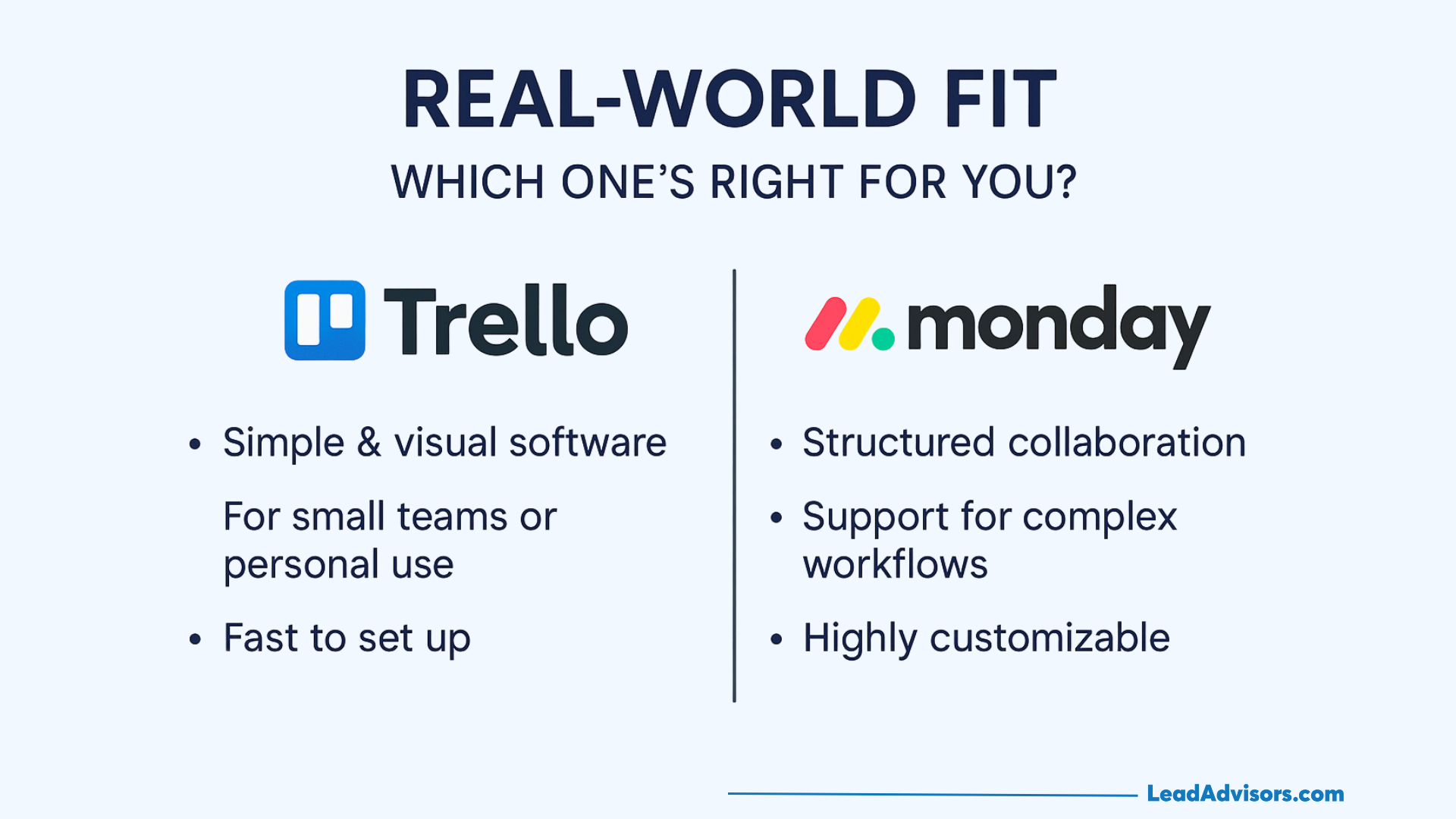
The decision between Trello and Monday.com depends on the team’s objectives, size, and the degree of complexity of the workflow. Both of them are great project management tools, but they are best suited to different environments.
Choose Trello if:
- You are looking for a very light, visual project management software that is usable by anyone without any prior knowledge.
- If the management of small teams or personal projects is what you do, and you choose simplicity rather than an advanced setup, then this software is for you.
- Apart from that, if you are looking for speed, affordability, and a user-friendly interface with minimal learning time, then these are the qualities that you will mostly appreciate in Trello.
Choose Monday if:
- You have the management of multiple teams, clients, or departments that need structured collaboration.
- In case you have a requirement for features such as capacity planning, time tracking, and task dependencies, to have your workflow be of a complex nature.
- If you are the one who wants to have a customizable platform that grows with your organization and also integrates with your tech stack, then choose Monday.
To sum up, Trello fits the teams that require quick arranging and a clear view of workflow, whereas companies with a focus on scaling, getting deeper performance insights, and automating processes would rather pick Monday.com.
Strengths & Weaknesses
Both Trello and Monday.com have their respective advantages and drawbacks, which largely depend on your team’s workflow and requirements. Below is a comparative analysis of the strengths of each platform.
| Trello | Monday.com | |
| Pros | Simple, intuitive, affordable, generous free plan, quick setup | Feature-rich, visually appealing, flexible, and highly customizable dashboards |
| Cons | Limited reporting, basic collaboration features, dated user interface | Higher cost, setup takes time, and it can feel overwhelming for beginners |
| Best For | Startups, freelancers, and small teams | Agencies, enterprises, and multi-department teams |
Trello can be considered a minimalist product that is budget-friendly, and hence it has been most popular amongst solo workers and small groups of people who want to manage their projects in an efficient and fast manner without the need for complex tools.
Conversely, Monday.com is loaded with a plethora of management features, state-of-the-art automation, and a stunning interface. Therefore, it suits large teams that need detailed data, well-defined workflows, and live collaboration on several projects at the same time.
Hands-On Verdict
The difference between Trello vs Monday.com emerges when one compares their approaches to work management and scalability. Both tools are ranked among the top project management platforms available in the market, and they can provide good performance for different types of teams.
Trello is the best use case when you just need a working system. Its visual design and Kanban board layout are very user-friendly and make it quite easy to track progress and manage projects. Teams can start working right away without the need for time-consuming onboarding processes and can communicate with each other without any problems.
The features of Monday.com mainly attract those teams who are looking for more structure, automation, and advanced insights. The use of Monday work tools, such as automation rules, dashboards, and workflow customization options, brings integration and coordination to a new level across the different departments. For sure, it is the most beneficial organization that deals with multiple projects, in which case the main issues, such as tracking, visibility, and reporting, become the biggest challenges that can be solved by this single platform.
In short:
Trello will effectively get the ball rolling with your work and keep you organized.
Monday work is the fuel that powers teams to manage, automate, and scale strategically at every level of their business.
Alternatives
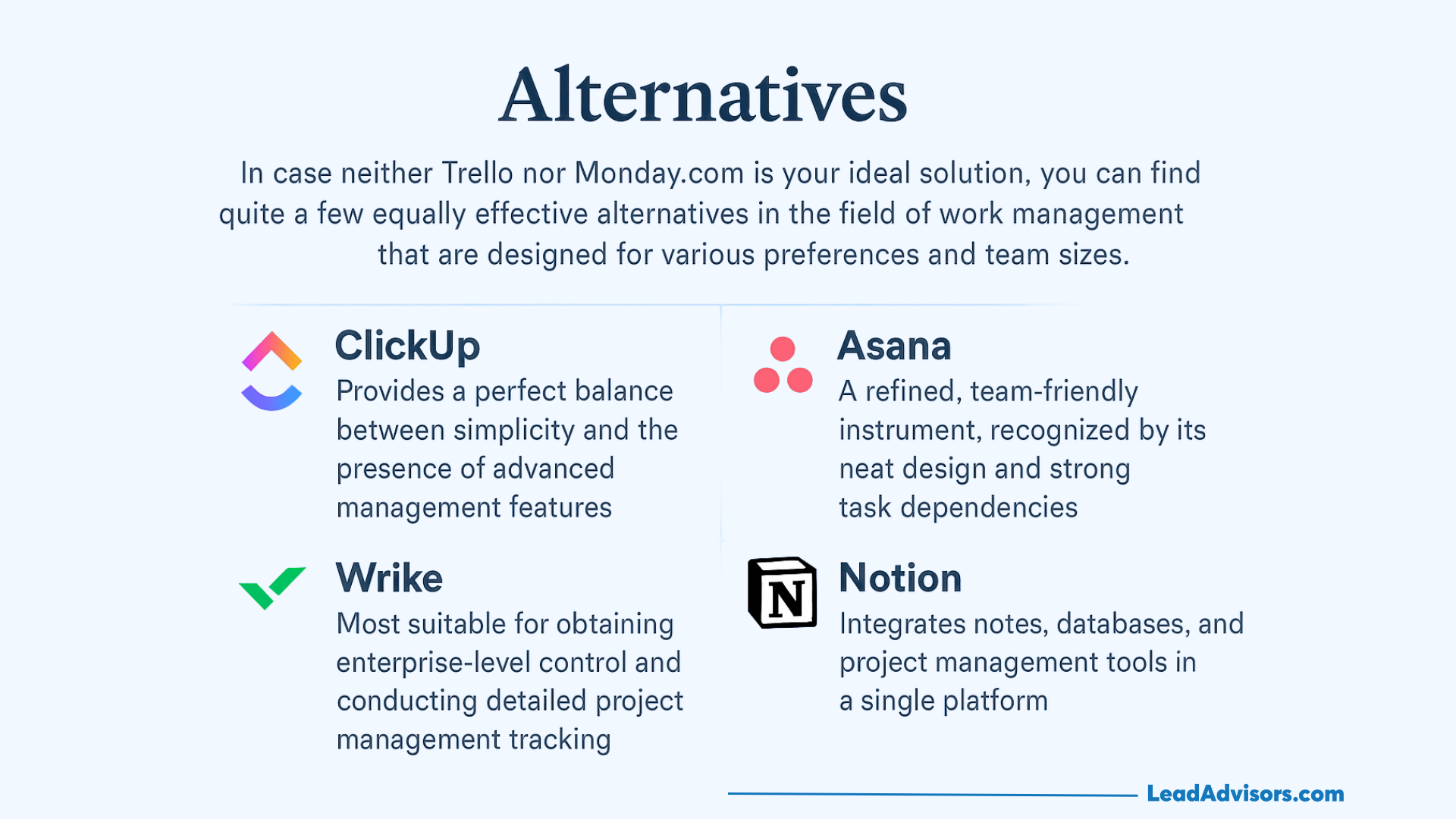
In case neither Trello nor Monday.com is your ideal solution, you can find quite a few equally effective alternatives in the field of work management that are designed for various preferences and team sizes.
- ClickUp – Provides a perfect balance between simplicity and the presence of advanced management features. It is quite adaptable, reasonably priced, and perfect for those teams that desire to have total control over their workflow.
- Asana – A refined, team-friendly instrument, recognized by its neat design and strong task dependencies. It serves well as a medium when comparing Asana vs Trello or Asana vs Monday, particularly for the teams that are in the process of growing.
Read more about: ClickUp vs Asana: Choosing the Right Project Tool
- Wrike – Most suitable for obtaining enterprise-level control and conducting detailed project management tracking. It helps big organizations with its deep reporting and integrations.
- Notion – Integrates notes, databases, and project management tools in a single platform, thereby being the best choice for those individuals and teams who put flexibility and creativity first.
These choices make it clear that the decision between Monday vs Trello depends on your work process, the number of people in your team, and the amount of customization your projects require.
Frequently Asked Questions
Should I use Trello or Monday?
Is Trello cheaper than Monday?
What are the disadvantages of Trello?
Is Monday.com the best management tool?
Is Trello still good in 2026?
Conclusion & Recommendation
Both Trello vs Monday.com are top management tools that rank high in the area of work management. Yet, the decision to go with one or the other depends on your team and the level of your project’s complexity.
Trello is definitely the way to go if what you want is a minimalistic, fast, and easy-to-use tool. It is the best choice for small teams, startups, and individuals whose main goal is to visually organize tasks without the hassle of additional layers of setup or cost.
On the other hand, if you are after sophistication and scalability, then the best option for you is Monday.com. The main features in Monday work management, such as automation, collaboration, and customizable dashboards, are directed towards big teams and organizations dealing with complex projects.
Both tools have been tested, trusted, and are powerful players in the work management field. The right decision largely boils down to your workflow, budget, and the level of structure your team requires to remain productive and aligned.

